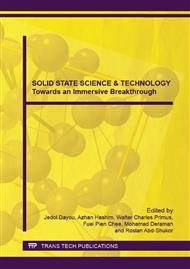[1]
Y. Wang, Y. Wu, Y. Huang, F. Zhang, X. Yang, Y. Ma, and Y. Chen, Preventing Graphene Sheets from Restacking for High-Capacitance Performance, J. Phys. Chem. C, vol. 115, no. 46, p.23192–23197, (2011).
DOI: 10.1021/jp206444e
Google Scholar
[2]
J. Yan, T. Wei, B. Shao, Z. Fan, W. Qian, M. Zhang, and F. Wei, Preparation of a graphene nanosheet/polyaniline composite with high specific capacitance, Carbon N. Y., vol. 48, no. 2, p.487–493, (2010).
DOI: 10.1016/j.carbon.2009.09.066
Google Scholar
[3]
Properties of activated carbon, CPL Carbon Link, 2013. [Online]. Available: http: /www. activated-carbon. com.
Google Scholar
[4]
D. Qu, Studies of the activated carbons used in double-layer supercapacitors, J. Power Sources, vol. 109, no. 2, p.403–411, (2002).
DOI: 10.1016/s0378-7753(02)00108-8
Google Scholar
[5]
D. Qu, Investigation of oxygen reduction on activated carbon electrodes in alkaline solution, Carbon N. Y., vol. 45, no. 6, p.1296–1301, (2007).
DOI: 10.1016/j.carbon.2007.01.013
Google Scholar
[6]
V. Mani, B. Devadas, and S. -M. Chen, Direct electrochemistry of glucose oxidase at electrochemically reduced graphene oxide-multiwalled carbon nanotubes hybrid material modified electrode for glucose biosensor, Biosens. Bioelectron., vol. 41, no. 0, p.309–315, (2013).
DOI: 10.1016/j.bios.2012.08.045
Google Scholar
[7]
D. R. Dreyer, S. Park, C. W. Bielawski, and R. S. Ruoff, The chemistry of graphene oxide., Chem. Soc. Rev., vol. 39, p.228–240, (2010).
DOI: 10.1039/b917103g
Google Scholar
[8]
Z. Fan, J. Yan, L. Zhi, Q. Zhang, T. Wei, J. Feng, M. Zhang, W. Qian, and F. Wei, A three-dimensional carbon nanotube/graphene sandwich and its application as electrode in supercapacitors., Adv. Mater., vol. 22, no. 33, p.3723–8, (2010).
DOI: 10.1002/adma.201001029
Google Scholar
[9]
C. X. Guo and C. M. Li, A self-assembled hierarchical nanostructure comprising carbon spheres and graphene nanosheets for enhanced supercapacitor performance, Energy Environ. Sci., vol. 4, no. 11, p.4504, (2011).
DOI: 10.1039/c1ee01676h
Google Scholar
[10]
H. X. Kong, Hybrids of carbon nanotubes and graphene/graphene oxide, Curr. Opin. Solid State Mater. Sci., vol. 17, no. 1, p.31–37, (2013).
Google Scholar
[11]
Admittance., [Online]. Available: http: /en. wikipedia. org/wiki/Admittance. [Accessed: 29-Dec-2013].
Google Scholar
[12]
G. P. Panta and D. P. Subedi, Electrical Characterization Of Aluminum ( Al ) Thin Films Measured By Using Four- Point Probe Method, J. Sci., vol. 8, no. 2i, p.31–36, (2012).
DOI: 10.3126/kuset.v8i2.7322
Google Scholar


